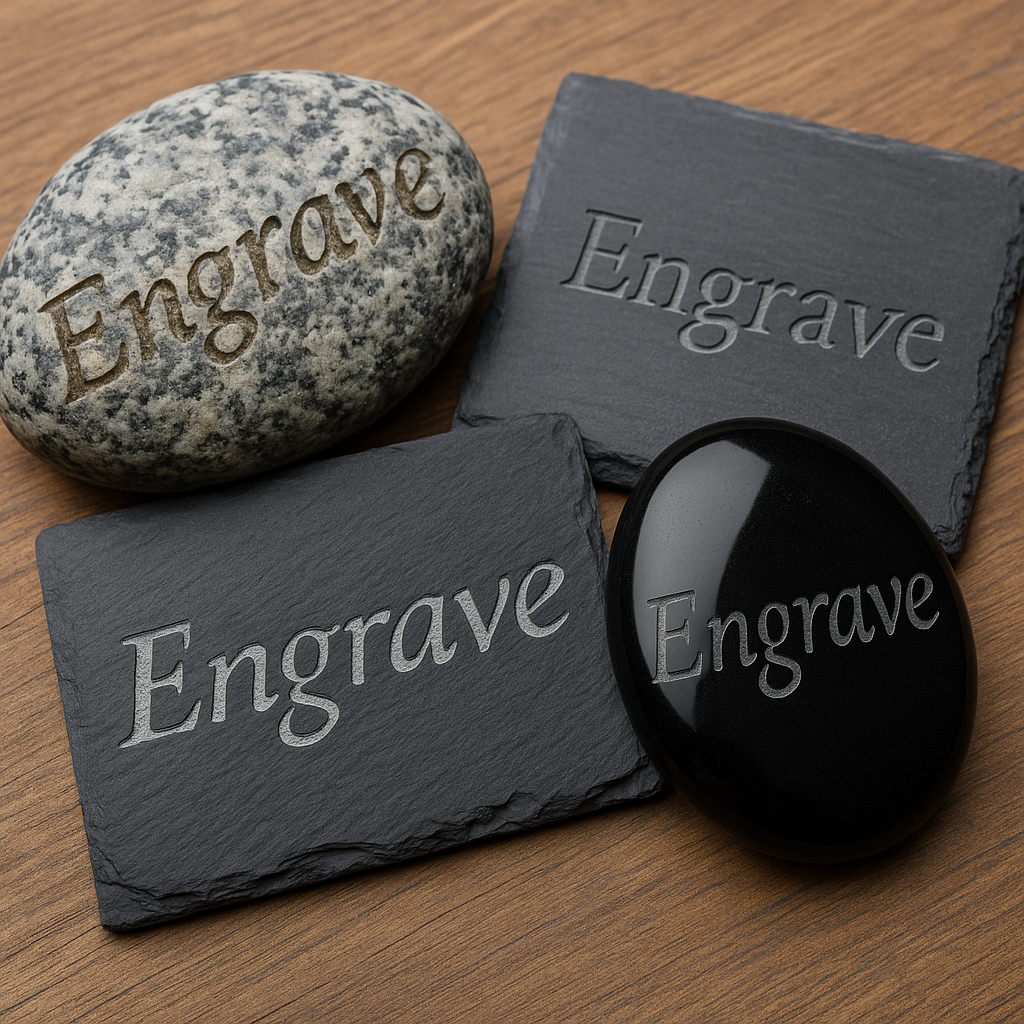Ever tried scratching your name into a pebble and thought, “What if this was granite?” The short answer: yes, you can engrave granite, slate, and obsidian—but each has quirks. With Laser Engravers for Stone, results can be stunning. Keep reading to learn the tricks for mastering these tough canvases.

Can You Engrave on Granite, Slate, and Obsidian?

Can You Engrave on Granite, Slate, and Obsidian?
How to Engrave Granite for Signage or Memorials
Settings for granite
Granite is one of the hardest natural stones—and that’s exactly what makes it so valuable for engravings meant to last generations. Memorials, gravestones, and architectural markers often rely on granite because it doesn’t weather easily and holds detail for decades.
To engrave granite, you’ll usually need high power and slow speed settings if you’re working with Laser Engravers for Stone. For example, many engravers start at 30–40% power, moving slowly to achieve depth. Too fast, and you’ll only scratch the surface. Too much power, and you risk burning the stone unevenly.
Each slab is slightly different depending on its mineral mix, so testing on a scrap piece is a must. Think of it as calibrating your recipe before cooking a full meal—you’ll get much better results.
Design considerations
Granite is naturally speckled, which is gorgeous in a kitchen countertop but tricky for fine engraving. Thin fonts or intricate shading can disappear into the stone’s natural “noise.”
That’s why many engravers stick to bold, sans-serif fonts for memorials or signage. If you do want detail—like a portrait or intricate logo—you can combine methods. For instance, sandblasting the background while laser-etching the detail gives a strong contrast and ensures readability. The rule of thumb? Make it bold enough to stand out from six feet away.
Tips for Slate Engraving (Popular for Coasters & Décor)
Why slate produces high contrast
Slate is often called the “crowd-pleaser” of engraving stones—and for good reason. Its dark, flat surface naturally reveals a lighter layer underneath when engraved, so your designs automatically stand out. No paints, fillers, or post-processing required.
This built-in contrast is why even simple engravings—like initials, a short quote, or line art—look polished and professional. And because slate is softer than granite, you don’t need heavy power settings. A mid-range laser or steady rotary tool is usually enough to get crisp lines.
Popular slate engraving projects
Slate is everywhere in the world of gifts and décor. Personalized coasters with wedding dates, bar signs with quirky quotes, and engraved cheese boards all start with a humble slab of slate. Etsy sellers swear by it because it’s inexpensive to source and customers love the rustic yet modern look.
For events, slate tiles make great custom favors or decorative signage. They’re affordable enough to produce in batches but still look high-end. Plus, they’re durable indoors, meaning the keepsakes will last long after the party is over. Slate has basically become the “gateway stone” for many hobbyists before they move on to harder materials.

Special Considerations for Obsidian and Gemstones
Obsidian’s unique reflective surface
Few stones turn heads like obsidian. With its mirror-like polish and deep black surface, engravings appear luminous when light bounces off them. Jewelry makers and artisans love it for pendants, decorative accents, and one-of-a-kind keepsakes.
But obsidian isn’t a stone in the traditional sense—it’s volcanic glass. That means it’s far more brittle than granite or slate. Even minor slips can cause chips, and the polished surface shows every scratch. To get good results, engravers need precision, patience, and a gentle hand.
How to avoid cracks and chips
Engraving obsidian is all about restraint. If you’re using a laser, stick to lighter passes at medium power, repeating as needed to build depth gradually. For rotary tools, diamond-tipped bits and a feather-light touch are essential. Push too hard, and you’ll hear that dreaded “crack” before your design is finished.
Temperature management is another big factor. Because obsidian responds poorly to heat, engraving too quickly can cause fractures. Keeping the stone cool—sometimes even misting with water between passes—helps prevent sudden breaks. With enough care, the end result can be breathtaking, but obsidian is best left for engravers who enjoy a challenge.

Which Stones Are Most Popular for Laser Engraving?
Granite, slate, marble, basalt
The most commonly engraved stones are granite, slate, marble, and basalt, each serving a different niche. Granite is the king of durability, used for gravestones, signage, and long-lasting monuments. Slate wins in décor thanks to its high contrast and affordability. Marble brings elegance, often chosen for plaques or high-end gifts, but it’s prone to chipping. Basalt, a dense volcanic rock, combines durability with smoother engravability, making it a favorite for signage and decorative panels.
These four stones form the backbone of most engraving projects. Whether you’re creating a heartfelt memorial or a trendy coaster set, chances are one of these will be your go-to material.
Emerging materials in hobby use
For hobbyists, newer options are gaining popularity. Soapstone and limestone are soft, inexpensive, and forgiving—great for practice or small gifts. River rocks are another DIY favorite; people love engraving names, short quotes, or doodles onto these rounded stones for gardens and keepsakes.
Some adventurous engravers are experimenting with semi-precious stones like jade or agate, though results vary. These materials are stunning but require specialized tools and techniques. As hobby lasers become more accessible, expect the list of engravable materials to grow. The takeaway? If it’s a rock, someone out there is probably trying to engrave it.



Leave a comment